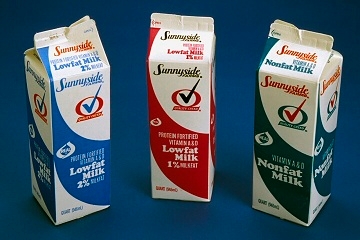- Author: Patti C. Wooten Swanson

Why?
Reduce your risk of cardiovascular disease by reducing the total fat, saturated fat, and calories you consume in milk and dairy products.
Whole and reduced fat (2%) milk are among the top food sources of saturated fat in the U.S. diet.
What's in one 8 ounce serving of milk?
|
|
Total |
Saturated |
|
|
Whole milk |
8 |
5 |
152 |
|
Reduced fat (2%) |
5 |
3 |
122 |
|
Low-fat (1%) |
2 |
2 |
101 |
|
Fat-free (Nonfat/Skim) |
1 |
0 |
90 |
Source: Dairy Council of California
Look what happens when you switch from whole to low-fat milk:
• Reduce total fat from 8g to 2g
• Reduce saturated fat from 5g to 2g
• Reduce calories from 152 to 101
Try these strategies to make the switch work for you and your family.*
Swap, substitute, and shrink
Substitute: 1% or nonfat milk in recipes and when preparing foods such as casseroles, soups, pudding, egg dishes, pancakes and waffles, or macaroni and cheese|
Shrink: Have a smaller glass of whole or reduced-fat milk or a smaller serving on your cereal, then make the rest of your dairy products low- or nonfat (yogurt, cheese, soy drinks)
Use the "step-down principle"
If you usually drink whole milk, make the switch gradually to give yourself time to adjust to the taste and texture differences.
_____Start with reduced fat (2%) milk
_____then switch to low-fat (1%) milk
_____and finally transition to fat-free (skim) milk.
Or, make the change more slowly.
If going from whole milk to 2% milk is too big of a jump, try mixing whole milk and 2% milk for a while. Once you've gotten used to that, switch over to 2% milk (only) and drink that until you are used to it.
Do the same when switching from 2% to 1% milk, and then from 1% to nonfat milk.
Tip: If you drink cappuccinos or lattes—ask for them with low-fat or fat-free (skim) milk.
* Children under 2 years should only drink whole milk, not reduced, low-fat or skim milk.



